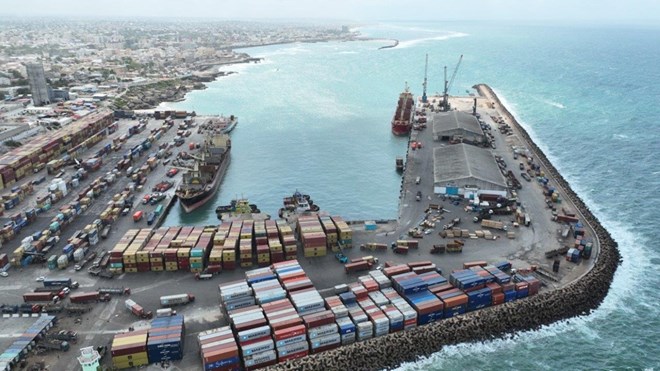.jpg)
Monday October 13, 2025
By Amb. Mohamed Ali Nur (Americo)

The Port of Mogadishu, Somalia’s largest harbour, is at a pivotal moment as rising regional trade among Eastern Africa ports creates new opportunities. Appointed Director General in August, I am prioritizing the modernization of operations, expansion of capacity, and strengthening of the port’s role in regional commerce.
The 2024 Container Port Performance Index (CPPI), released by the World Bank and S&P Global Market Intelligence in September 2025, ranked Mogadishu as the most efficient port in East Africa, ahead of Mombasa, Dar es Salaam and Djibouti. It also emerged second in Sub-Saharan Africa, after Senegal’s Dakar Port.
As Somalia rebuilds its economy with a focus on infrastructure upgrades and private-sector growth, Mogadishu Port remains essential to national development. It generates a sizeable share of federal revenue and serves as the country’s main gateway for imports such as food staples, fuel, and construction materials. The port is equally critical for exports, where livestock and fisheries dominate. In 2024, the port handled an estimated 1.5–2 million tonnes of cargo.
Port operations and cargo volumes have steadily improved under Mogadishu Airport, a subsidiary of the Albayrak Group. The company manages the facility in coordination with the Mogadishu Port Authority, which represents Somalia’s federal government.
A new container terminal opened in August, raising annual capacity from 150,000 to 250,000 twenty-foot equivalent units (TEUs). The port now processes about 6,000 containers each month, with liner services calling 10 to 15 times monthly. Congestion has eased, demonstrating how investment and improved management can deliver results as the country continues to stabilize.
Under the guidance of the federal government, the Mogadishu Port Authority is advancing plans to construct a new, state-of-the-art port facility about 35 kilometers outside Mogadishu. This strategic project aims to accommodate rapidly increasing maritime trade while reducing congestion at the existing port.
The feasibility study for this landmark initiative is complete, presenting a comprehensive plan for a greenfield port that goes far beyond a traditional seaport. The development will feature a Special Economic Zone (SEZ) with a free zone for transshipment cargo, advanced logistics hubs, and dedicated areas for light industries and small factories, creating a modern hub for trade, manufacturing, and regional connectivity.
The project has now entered the tendering stage, with efforts underway to secure financing from investors, international financial institutions, and development partners. Once implemented, this integrated port and economic zone will transform Somalia’s role in regional and global trade, attract substantial foreign investment, and drive sustainable economic growth for the nation and the region.
These upgrades will speed vessel turnaround and improve handling of perishable exports such as fish and livestock. The port’s six wharves, five 160-metre general-cargo berths and a 200-metre container terminal, already manage dry bulk and other goods. This work is part of the US$650 million New Mogadishu initiative, a government-led infrastructure program designed to modernize Somalia’s capital and attract foreign investment.
East African ports handle more than US$100 billion in trade each year, and landlocked neighbours such as Ethiopia and South Sudan need reliable sea outlets. Mogadishu’s location gives it a natural regional role. The port sits astride major shipping lanes, offering shorter routes for goods moving between the Horn of Africa, the Gulf, and Asia. Planned road links within Somalia and the ongoing stabilization of the country will extend this reach and connect the country’s interior to global markets.
Economic benefits will extend far beyond the waterfront. By 2030, the port expects to double annual revenue to about US$500 million and create more than 5,000 direct jobs and 20,000 indirect jobs in transport, logistics, and agro-processing. Stronger transport links, including connections to the Lamu–South Sudan–Ethiopia (LAPSSET) corridor and other regional infrastructure projects, will provide another dependable route to the Indian Ocean for traders in Uganda, Kenya, and Ethiopia.
A stronger Port of Mogadishu benefits the entire region. It supports the East African Community’s goal of deeper economic integration, strengthens ties among Intergovernmental Authority on Development (IGAD) states, and advances the African Continental Free Trade Area by easing the movement of goods across the continent. Farmers, manufacturers, and traders throughout the region gain from a secure and efficient Somali gateway to global markets.
The port’s expansion and the planned new facility reflect Somalia’s broader stabilization. Continued investment, improved security, and active regional cooperation can make the Port of Mogadishu a cornerstone of economic renewal for Somalia and a vital link in Africa’s trading network.
Amb. Mohamed Ali Nur (Americo) is the Director General of Mogadishu Port and former Somali envoy to Kenya.